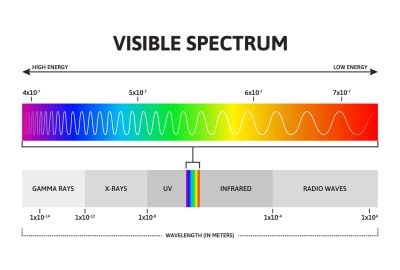Grow Light Distance Chart For Cannabis Plants: The Definitive Guide
Are you planning on growing some indoor marijuana seeds? Before you start, it’s vital to consider your cultivation space and how you want to illuminate it. If you need help figuring out the specifics, we’ve got your back with some grow light distance charts.
Read on to learn about the importance of setting your lamps at the proper intervals. There’s also an overview of the different lamp options and tables to help determine your grow light distance.
Why is the grow light distance important?
Visible light, in scientific terms, refers to the band of the EM spectrum that the human eye senses. The light spectrum for cannabis has a slightly different EM radiation range containing frequencies outside the scope of what we see.
To talk about this spectrum of EM radiation that plants need, we use the term PAR. This abbreviation stands for photosynthetically active radiation.
The amount of PAR given off by a source is measured in PPF (photosynthetic photon flux) units. PPF measures micromoles radiated per second (µmol/s).
As PAR radiates outward, it travels in all directions, and not every micromole reaches your plants. Another measurement is required to determine how well-lit your crops are, like PPFD or photosynthetic photon flux density.
PPFD increases closer to your canopy, as less space to travel means lower falloff. The reverse is also true. When it comes to cannabis, light distance is crucial for achieving the best yields.
It’s important to remember that the change in distance and PPFD isn’t linear. PAR falloff obeys the inverse square rule. In other words, doubling the distance from your plants results in a PPFD with 25% of its previous value.
Light intensity isn’t the only factor in setting your distances. Older HID bulbs produce too much warmth, so placing them too close may lead to heat stress. LED and CFL systems are much cooler but still risk causing cannabis light burn at close proximity.
Another factor to consider is the stage of growth. The ideal light distance for seedlings is different from vegging. Hot HID lamps shouldn’t sit near tender sprouts, but even with LED, light distance from seedlings should remain reasonable.

Grow light distance charts: The most common types of grow lights for weed plants
There are three main categories of indoor grow lights for cannabis, each with advantages and disadvantages. Below is a brief overview of each type and a handy reference table for setting up your grow-op.
Lights use watts as a determining factor, but this term only refers to power use. How far should a light be from a weed plant? It depends on the type, the amount of heat, and the number of PAR units.
A 200-watt LED emits higher intensity PAR than a 200-watt HID lamp. Determining how far an LED light should be from your weed plants differs from other kinds. That’s why more people are moving towards using PPFD as a standardized measure.
LED grow light distance chart for growing weed
LEDs are fast becoming the standard thanks to a raft of unique features. Before gushing over these high-tech wonders, let’s take care of the downsides. LEDs aren’t cheap, with top-of-the-range units costing four-figure sums.
They come highly recommended if you’re lucky enough to afford an LED setup. Although the initial costs are high, their energy efficiency may mean you end up saving money in the long term.
Their power-to-performance ratio is also excellent, producing high-intensity illumination to rival HID lamps at a fraction of the cost. Switching bulbs for flowering is unnecessary. LEDs deliver a user-defined spectrum suitable for all growing stages of your indoor weed seeds.
Settings for spectrum and intensity are available on most quality LED systems. They usually contain an internal timer, accommodating the light cycle for weed without additional equipment.
Use this LED grow light distance chart to calibrate your setup:
| Wattage | Seedling stage | Vegetative stage | Flowering stage |
| 200 | Up to 20 inches | 12–20 inches | 8–16 inches |
| 400 | Up to 27 inches | 20–27 inches | 13–21 inches |
| 600 | Up to 38 inches | 30–38 inches | 18–30 inches |
| 800 | Up to 42 inches | 32–42 inches | 19–34 inches |
| 1000 | Up to 46 inches | 36–46 inches | 21–36 inches |

CFL light distance chart for growing weed
CFL stands for compact fluorescent light. The low cost and minimal power draw mean they’re ubiquitous in office complexes, stores, and similar spaces. However, standard CFLs aren’t ideal for cultivating as they emit relatively low amounts of PAR.
When it comes to CFLs and cannabis, T5 grow lights are the most common. They usually contain multiple tubular bulbs and provide enough PAR for vegging a small number of plants.
On top of being cheap to run, growing cannabis with fluorescent lights produces very little heat. Placing them near your plants is possible, as they increase your PPFD without damaging your crops.
A grow light distance chart for CFLs is unnecessary. Keep your bulbs 2–4 inches away from the canopy at all times. Remember, CFLs generally aren’t powerful enough to provide the expected results when used during flowering.
HID light distance chart for growing cannabis
HID stands for high-intensity discharge and covers metal halide and high-pressure sodium lamps. Until the arrival of LEDs, HIDs were the most effective choice for producing high yields.
While powerful, HIDs consume large amounts of electricity, making them expensive to run over long periods. They also produce a lot of heat and must sit further from the plants to prevent problems.
HID lamps aren’t overly expensive, but you must buy an additional ballast and reflector hood to use them. Ideally, HID users run an MH bulb for vegging and switch to an HPS once flowering begins.
HID grow lights are effective but less energy-efficient and hotter than LED systems. If you’re a beginner and have the budget, consider investing in LEDs for long-term savings in energy costs.
The HPS light distance chart below is limited to the flowering column. The seedling and vegetative columns assume the use of an MH bulb.
| Wattage | Seedling stage | Vegetative stage | Flowering stage |
| 200 | Up to 13 inches | 4–13 inches | 4–15 inches |
| 400 | Up to 18 inches | 7–18 inches | 7–21 inches |
| 600 | Up to 27 inches | 10–27 inches | 10–28 inches |
| 800 | Up to 29 inches | 11–29 inches | 11–31 inches |
| 1000 | Up to 31 inches | 12–31 inches | 12–35 inches |
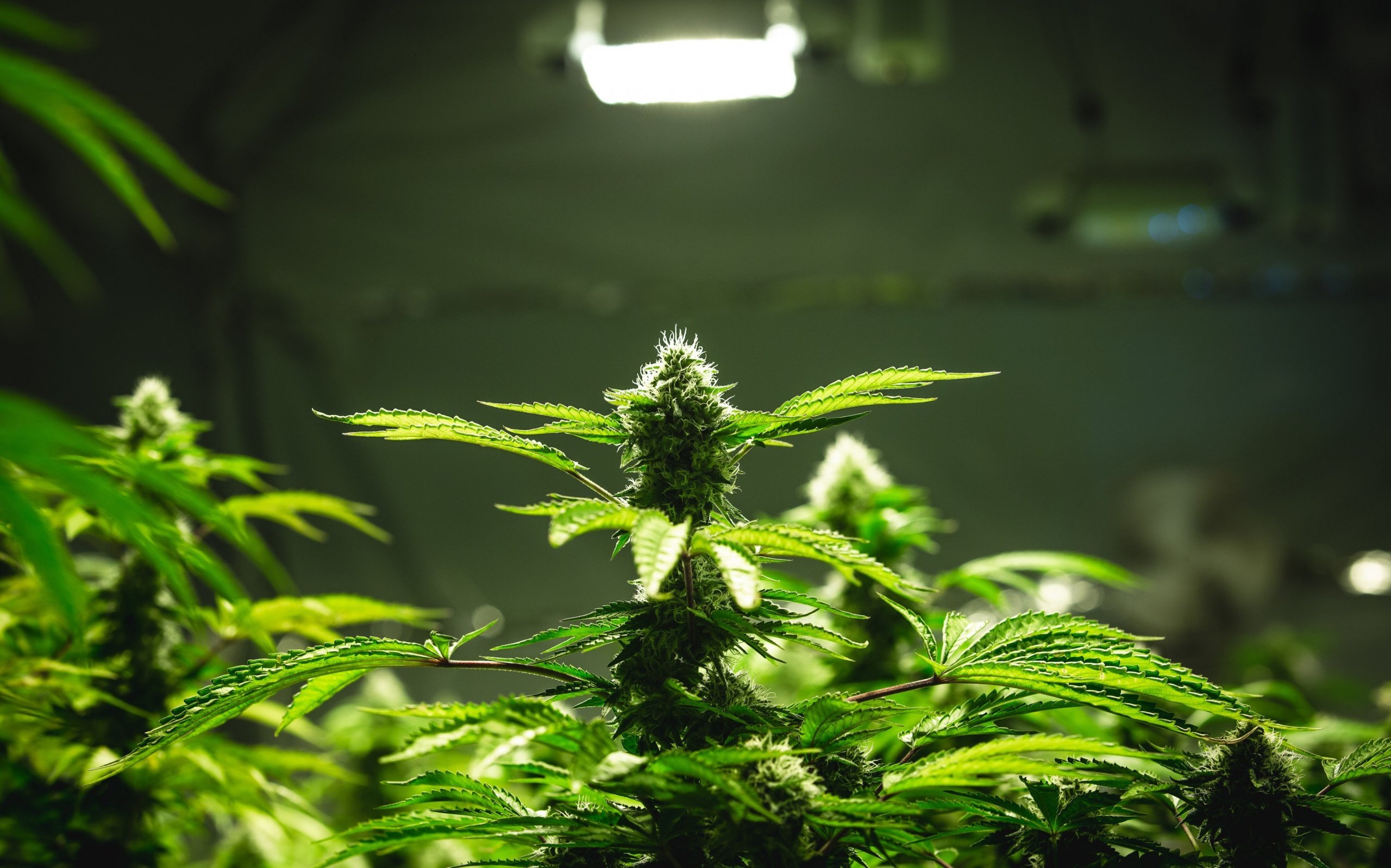
CMH light distance chart for growing cannabis
Ceramic metal halide (CMH) lamps are a variation of HIDs. They contain a ceramic filament that burns at hotter temperatures than regular MH lights. CMH bulbs emit a fuller spectrum of PAR and are more suitable for use during vegging and flowering.
CMH grow lamps run hotter than LED systems but cooler than standard HIDs. As this grow light distance chart shows, closer canopy distances than HIDs are possible:
| Wattage | Vegetative stage | Flowering stage |
| 315 | 11–14 inches | 18–20 inches |
| 630 | 13–16 inches | 24–26 inches |
How can I measure light intensity for cannabis plants?
There are two main ways to measure your lights’ intensity, requiring specialized equipment. The first is to use a PAR meter. This tool detects the range of EM radiation your plants need for photosynthesis.
A PAR meter provides a highly accurate reading, but its cost exceeds most home growers’ budgets. As a result, those who wish to test the intensity of their grow lamps typically use a lux meter.
Film crews and photographers often use these meters to measure lumens, but they also work well for HID lamps. Lux meters are less effective at reading LEDs, as they’re designed to sense incandescent bulbs.
This tool gives you a fair approximation of the intensity of HID bulbs. Using a lux meter is simple; expose the sensor at canopy height and record the measurement. Record a series of calculations in different locations for best results.
If you want to create an accurate light intensity map, run string across your grow room to create a grid. Measure each box, then map out the results on paper or in a spreadsheet. This method can help you determine the correct grow light distance.
The data you record is measured in lux. Ideally, you should provide 15–50,000 lux during vegging and 45–70,000 during flowering. While using a lux meter is better than nothing, PPFD data maps from manufacturers are preferable and require less work.
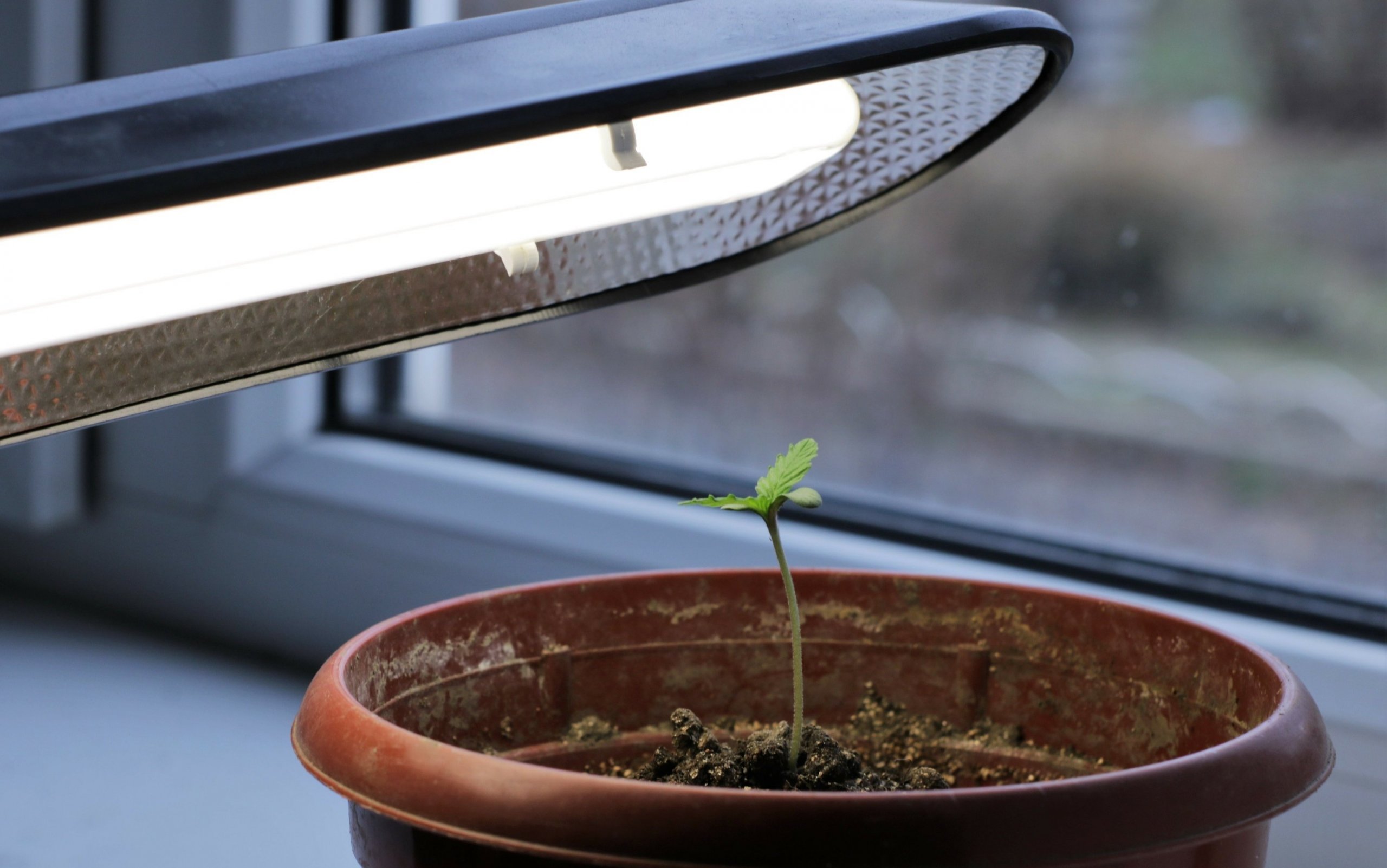
Negative effects of too much light for cannabis
Cannabis is highly tolerant to large amounts of illumination, but providing too much may result in problems. Pay attention to your plants after altering any aspect of their routine.
If you notice any of the following symptoms, raise your lamps or lower their intensity immediately. The wrong light height for weed may cause:
- Leaf burn: Outer sections of the blades close to the light turn brown. Further discoloration of more extensive parts follows. Leaf burn is easily misidentified as symptoms appear similar to nutrient burn.
- Bleaching: This complication typically presents as yellowish or white-colored spots appearing on foliage.
- Irregular growth: Unusual growth may indicate your cannabis light distance is too close. Symptoms include limp limbs, drooping foliage, or excessive leaf shedding. Blades curling in on themselves is another sign of too much light and possibly heat.
Adverse effects of too little light for marijuana
Although you shouldn’t ignore the impacts of too much illumination, it’s also important not to go too far in the other direction. On top of decreasing their productivity, a lack of sufficient PAR for your plants may cause another issue.
If the grow light distance is too far, plants begin a process known as etiolation—often referred to as stretching. As the name suggests, it causes accelerated growth in light-deprived specimens. Beginners often consider this a positive sign, but it’s the opposite.
Entering this state causes stress as the plants engage their survival mechanisms to photosynthesize the energy they need. While it may look like flourishing growth, stretching lowers the productivity of your cannabis.
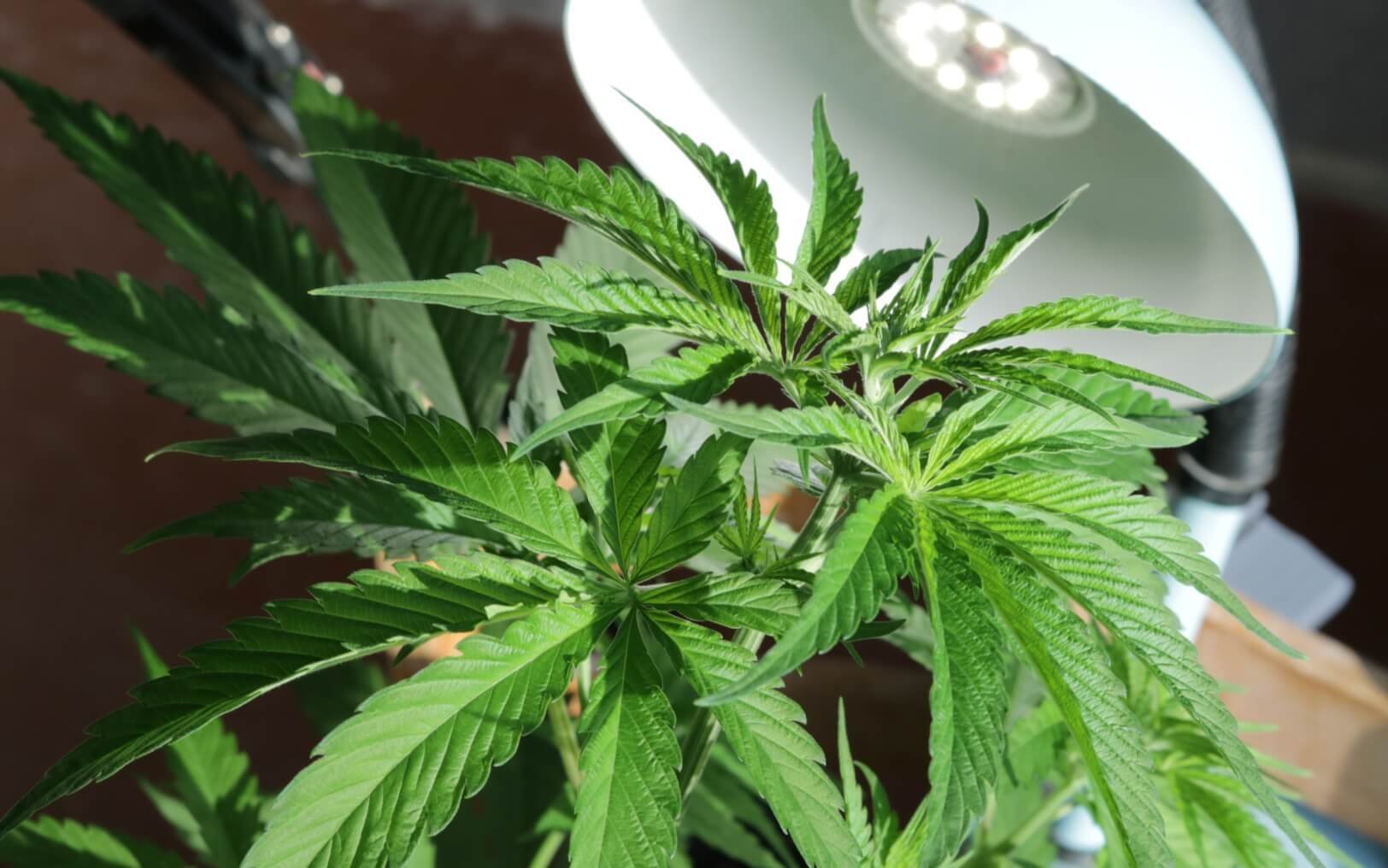
How many plants can your lights grow?
If you’re returning to cultivation after some time, you’re probably accustomed to using watts to determine your coverage. This technique was useful when lamps were limited to HIDs, but less so with the arrival of LED lights for cannabis.
LED grow lights are more efficient than the old, power-hungry HID bulbs. They use fewer watts of power to output intensity approaching HID levels. As a result, applying old watts per square knowledge won’t work for LED setups.
The best way to figure out how many plants you can support goes back to PPFD. All reputable brands now supply PPFD data in their specifications sheet, making it easy to plan your grow light distance.
If your chosen lamps doesn’t provide this data, the only way to find out is by testing it. As that’s not always an option, reach out to the manufacturer before buying. If they can’t give you detailed specifications, choose another product.
Below is a mockup PPFD chart we created for a nonspecific LED covering a hypothetical 5x5 foot space. The chart shows the PPFD data for this area when installed at a height of 24 inches. Remember, this is for illustrative purposes only; every light differs.
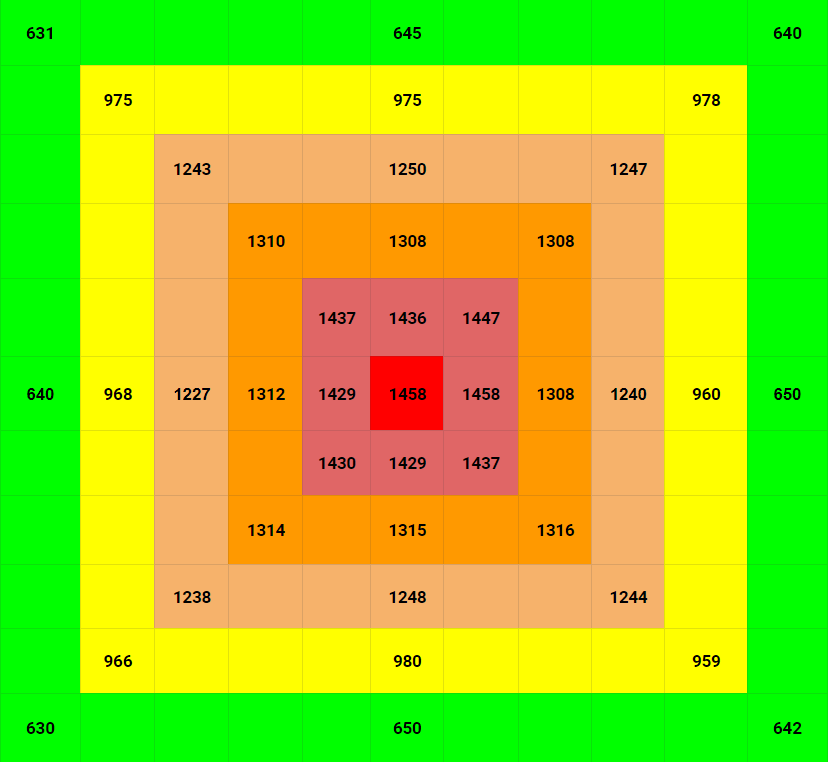
Notice that the PPFD or light intensity falls off as it travels towards the exterior of its footprint. Plants along the outside receive less than half of the PAR in the center. Accounting for falloff is essential and a factor often left out of old grow light distance charts.
The next thing to consider is vertical light falloff. The further away from your plants, the less intense the light that reaches them is. Most manufacturers provide multiple PPFD charts at different heights, so look at the one that fits your needs.
In the above example, let’s say the grow light distance and PPFD are sufficient across the board. It would mean it adequately covers an area of 25 square feet. A properly lit room this size should easily support 8–10 plants taking up two square feet each.
Ensuring sufficient light coverage for all your plants is critical. It’s also important to remember that different strains and growing methods produce varying plant sizes.
If you don’t know or can’t determine your PPFD with HIDs, don’t stress. Use this table as a general guide along with the grow light distance charts to plan your setup:
| Wattage | Coverage | Plants |
| 250 | 0.5–1m² | 2 |
| 400 | 1–1.5m² | 4 |
| 600 | 1.3–2m² | 8 |
| 1000 | 1.8–3m² | 10 |
Read our report on "PPFD for autoflowers" to keep learning about this.
Let there be light
Optimally setting up your lights takes a bit of work, but improved yields make it worth the effort. With the above knowledge, dialing in the perfect distance should be much easier.
If you found this article helpful, why not check out other blogs in our How to Grow Marijuana series? Don’t forget to browse our wide selection of cannabis seeds while you’re there.
About the author: Derek LaRose
Also known as Kronic from The Cannabis Kronicles, Derek LaRose is a young ambitious cultivator and a staple educator for indoor cultivation.
